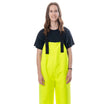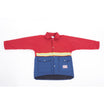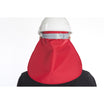When striding onto a construction site, it's as if you're stepping into an entirely different world. Amidst the drone of power tools and the cacophony of colliding materials, construction workers stand out like armored knights, ensheathed in heavy gear, managing daunting tasks with dexterity. But behind this seeming display of strength and resilience lie discomfort and potential health risks associated with prolonged use of weighty gear. This article aims to shed light on the physical demands of construction work, the types of heavy equipment used, and most importantly, the comfort tips for wearing such gear. From understanding the importance of proper fit to recognizing the need for breaks, we will explore how comfort can substantially improve a construction worker's performance and job satisfaction.
Physical Demands of Construction Work
Construction work is among the most physically demanding occupations there is. Workers are frequently required to perform strenuous tasks, operate heavy machinery, and work under challenging conditions. The following section delves into the various physical challenges construction workers typically face, emphasizing the importance of proper gear to protect workers from unnecessary strain and potential health risks.
Prolonged Wearing of Heavy Gear
A significant aspect of the physical demands in construction work comes from the extensive use of protective gear. Helmets, work boots, gloves, and in some cases, even body suits are frequently worn for safety measures. These items are often quite heavy and need to be worn for prolonged durations. This can lead to fatigue, discomfort, impaired mobility, and in more serious cases, musculoskeletal disorders. Some common issues include lower back pain, knee injuries, and hand strains.
Potential Health Risks
Exposure to potential health risks is another central concern for those in the construction industry. Tasks frequently involve handling dangerous materials or working under risky circumstances. For instance, dust inhalation is a common issue in construction sites, potentially leading to respiratory conditions. Similarly, repeated exposure to loud noise can result in hearing loss. Protective gear, while necessary, can exacerbate these issues by increasing physical strain.
Importance of Comfortable Gear
In light of these challenges, it becomes vital to strike a balance between protection and comfort in choosing construction gear. As the link between comfort and durability in gear has been established, it's beneficial to opt for equipment that mitigates the strenuous nature of construction tasks without compromising safety. For instance, lightweight helmets with padding can reduce neck strain, while ergonomic gloves can lessen the risk of hand injuries.
While the physical demands of construction work are undeniably significant, with the right gear, many of these challenges can be effectively mitigated. It's crucial for industry professionals and employers to recognize these demands and equip their workers with gear that offers both safety and comfort, ensuring a healthier and more productive work environment.
Types of Heavy Gear Used in Construction
Personal Protective Equipment
Protection always comes first in any line of work, especially in construction. Workers are everyday exposed to potential hazards, such as falling debris, intense noise, and harmful substances. Hence, every construction worker should be equipped with personal protective equipment (PPE), which includes:
- Hard hats: Protect the wearer's head against impacts, shocks, and debris.
- Safety glasses: Shield the eyes from dust, debris, flying particles, and glaring light.
- Respirator masks: Prevent the inhalation of airborne contaminants and toxic gases.
- Ear protection: Safeguard the ear from loud noises that may cause hearing loss.
- Work boots: Resistant against penetration, chemicals, and electrical hazards. These are some of the Work Gear Essentials for Construction, ensuring safety while performing the work.
Tools and Equipments
Apart from the PPE, construction workers also need specific tools and equipment to perform their jobs effectively. These include but are not limited to:
- Excavators: They are used for digging and moving large amounts of earth.
- Bulldozers: Excellent for pushing large quantities of soil and debris around a construction site.
- Loaders: Known for their versatility, loaders can move dirt, feed hoppers or load trucks with raw materials.
- Forklifts: These are indispensable in warehouses and large construction sites for materials handling and lifting.
- Hoist and cranes: Essential for lifting heavy materials and tools to elevated heights.
Working in construction entails a tremendous amount of responsibility, especially when handling these heavy tools and equipment. Therefore, a thorough understanding, proper training and regular reminders related to safety procedures are a must. By equipping workers with the right gear and adequate knowledge, we not only ensure their safety but also the smooth operation and successful completion of construction projects.
Comfort Tips for Wearing Heavy Gear
Wearing heavy gear can be daunting, especially if the activity lasts for an extended period. Although these protective gears are designed to be robust and durable, they can be uncomfortable if not properly managed. Fortunately, with these proven tips and tricks, you can optimize comfort levels even while fully equipped with heavy gear.
Proper Fit and Adjustments
First and foremost, ensure that your gear fits well and is properly adjusted to your body. This is not just about aesthetics; a well-fitted gear eases the strain on your body and prevents potential injuries. Let's unpack some key aspects:
- Correct Sizing: Most gears come in various sizes. It's crucial to select the one that aligns best with your body size.
- Customization: Some gear allows you to adjust the straps and belts. Customize these according to your comfort needs.
- Weight Distribution: Even distribution of weight can vastly improve comfort. Pay attention to the arrangement of your gear to avoid stressing specific body parts.
"The comfort factor in any gear depends a lot on the way it fits and is adjusted to the body."
Breaks and Rest Periods
Next, it is essential to honor the need for breaks and rest. While it might feel productive to push through, not taking breaks can lead to fatigue and reduce overall effectiveness.
- Plan your breaks. Try to remove or loosen up the heavy gear during these periods to let your body relax.
- Utilize these breaks to stretch and move. This works wonders in preventing muscular cramps associated with prolonged gear use.
- Time your breaks in a way that aligns with your natural energy rhythms. Listen to your body and know when to take a pause.
Training for Physical Preparedness
Your body's physical preparedness can play a significant role in determining comfort levels while wearing heavy gear. The fitter you are, the easier it becomes to endure the extra load your body has to carry.
- Incorporate strength training into your routine. This helps your body get used to carrying additional weight.
- Cardio workouts can help improve stamina, which is crucial when you're on your feet for long periods wearing heavy gear.
- Don't forget flexibility exercises. They help in ensuring that your body stays limber and can move easily even in cumbersome gear.
Nutrition and Hydration
Your diet and hydration status can dramatically affect overall comfort. Keeping your body well-nourished ensures that you have enough energy to carry the heavy gear.
- Focus on consuming balanced meals rich in proteins, carbohydrates, and healthy fats.
- Keep yourself hydrated. Drink water at regular intervals to prevent dehydration which can lead to fatigue and discomfort.
- Consider taking electrolyte-rich beverages if your activity involves high energy expenditure or if you're in a hot environment.
Remember, every person is unique. What works well for one person might need adjustments to suit another. So, experiment with the above tips and find a routine that works best for you. It's all about enhancing comfort and performance when tackling the demanding task of wearing heavy gear.
Effects of Comfortable Gear on Work Performance
A workplace can be seen as a second home, considering the considerable amount of time workers spend there. As at home, comfort plays a critical role in ensuring an enjoyable experience—a principle that holds especially within industries requiring physical work or interaction with challenging environmental conditions. Comfortable gear has a profound influence on work performance, a concept that can manifest in various ways, such as an increase in productivity, a decrease in injury risks, and an improvement in overall job satisfaction. Let's break it down to understand this better.
Increase in Productivity
First and foremost, the comfort afforded by wearing suitable gear facilitates an increase in productivity. When workers are not distracted by discomfort, they can fully concentrate on the task at hand, which contributes to enhanced efficiency and, subsequently, increased productivity. Contributing factors are:
- Reduced physical strain: Comfortable gear supports better posture and reduces physical strain, enabling workers to put their energy into productive tasks.
- Lesser fatigue: With reduced physical strain comes less fatigue, letting workers maintain a stable pace of work for more extended periods.
- Better focus: Good gear eliminates uncomfortable distractions, allowing workers to maintain better focus, which directly contributes to higher productivity.
Decrease in Injury Risks
A direct consequence of wearing comfortable gear—correctly fitting helmets, knee pads, gloves, etc—is a significant decrease in injury risks. To uphold the motto of "Transforming Safety with Improved Gear", these aspects should be considered:
- Prevents slips, trips, and falls: Anti-slip boots and other similar safety gear can effectively prevent accidents caused by slips, trips, and falls.
- Guards against environmental risks: Comfortable gear serves as a protective layer against environmental hazards like extreme weather, sharp objects, etc.
- Ensures durability: Comfortable work gear is often durable, implying it possesses the resilience to withstand adverse conditions and protect its wearer effectively.
Improvement in Job Satisfaction
Last but not least, the right gear can lead to better feelings about the job itself. Job satisfaction emanates from not just monetary or promotional benefits but also from secure and comfortable work conditions. Here's how comfortable gear can boost job satisfaction:
- Raises morale: The simple act of providing comfortable gear shows that an employer values their employees' well-being, inherently boosting morale.
- Lessens absenteeism: With less physical discomfort and risk of injury, employees are less likely to take sick leave, which provides a more consistent and satisfactory work experience.
- Promotes a positive outlook: A comfortable and safe working environment nurtures a positive outlook towards the job, leading to higher satisfaction levels.
In a nutshell, don't underestimate the impact of comfortable gear on work performance. Simply put, it has the potential to redefine work experience by enhancing productivity, decreasing injury risks, and elevating job satisfaction.
Conclusion
Working in a physically demanding environment such as a construction site can pose various challenges. By maintaining a pro-active approach in comprehending the physical demands, recognizing the role of heavy gear, executing comfort strategies, and understanding the positive implications of comfortable gear on work performance, individuals can effectively manage their worksite responsibilities.
In the end, remember that comfort on a construction site is not a luxury—it is an absolute necessity. This comfort often starts from the ground up, with boots, then pants. Quality brands, such as Rain Gear Pro, offer construction workers durable, comfortable, and highly protective chainsaw safety pants that cater to these essential factors. Their chainsaw safety pants are designed to hold up against the rigorous demands of a construction site, ensuring that you are free to focus on getting your job done, without worrying about your gear.
By incorporating these factors into your work life, your productivity, job satisfaction, and overall construction site experience can be greatly improved. After all, when you're comfortable, you're capable of performing your best. Remember to pay heed to the comfort, durability, and safety offered by your gear, and you'd be geared up for success on the construction site! Be sure to check out the range of products available at Rain Gear Pro to ensure you're always ready and comfortable on the job.
Frequently Asked Questions
-
What are some comfort tips for wearing heavy gear on construction sites?
Some comfort tips for wearing heavy gear on construction sites are: 1. Ensure proper fitting of the gear, 2. Use moisture-wicking and breathable materials, 3. Take regular breaks to rest and cool down, 4. Stay hydrated throughout the day, and 5. Use padding or cushions for added comfort.
-
How do I ensure proper fitting of heavy gear?
To ensure proper fitting of heavy gear, take accurate measurements of your body and choose the right size. Adjust straps, belts, and buckles according to your comfort, and make sure the gear allows easy movement without restricting your mobility.
-
Why is it important to use moisture-wicking and breathable materials?
Using moisture-wicking and breathable materials in your heavy gear helps in managing sweat and moisture, keeping you dry and comfortable. These materials prevent the build-up of heat and reduce the risk of skin irritations and discomfort.
-
How often should I take breaks while wearing heavy gear?
It is recommended to take regular breaks every 1-2 hours when wearing heavy gear on construction sites. Utilize these breaks to rest, hydrate, and cool down to avoid overheating and reduce fatigue.
-
Can I use extra accessories for added comfort while wearing heavy gear?
Yes, you can use padding, cushions, or gel inserts to enhance comfort while wearing heavy gear on construction sites. These accessories provide additional support and reduce pressure points, easing the strain on your body.





















Leave a comment
This site is protected by hCaptcha and the hCaptcha Privacy Policy and Terms of Service apply.